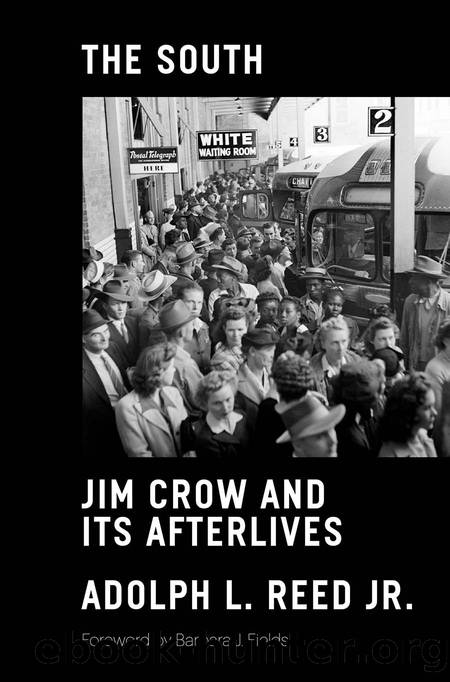The South by Adolph L. Reed Jr. & Barbara J. Fields

Author:Adolph L. Reed, Jr. & Barbara J. Fields
Language: eng
Format: epub
Publisher: Verso Books
3
âRaceâ and the New Order
Taking Shape within the Old
Warren County was, and remains, sparsely populated; in the mid-1970s its total population was around 16,000. It was majority minority, and that population was apportioned among blacks, who were the countyâs overall majority, Lumbee Indians, and another, considerably smaller group known as the Haliwa or Haliwa-Saponi Indian tribe. Many of those officially recognized as black in the area were phenotypically indistinguishable from Lumbee and Haliwa-Saponi groups. Contextual and other tacit cues helped inform reasonably accurate guesses as to who was considered what among them. The Haliwaâthe name comes from Halifax and Warren, the two counties where the group livesâbecame known as a distinct identity-group only in the postâWorld War II decades. I had heard of them since my college years as a population that simply decided no longer to be black and crafted a Native American identity for itself. Friends from the area confirmed that during the late 1940s and 1950s some of their own families split irrevocably over whether to retain their recognized black racial status or pursue Haliwa identity. In 1957 the Haliwa created racially separate elementary and secondary schools, which the state and county education agencies recognized, and in 1965 they successfully petitioned the legislature to recognize the group name and change designations on its membersâ birth certificates from âthe colored raceâ to âthe Indian race.â The Haliwa schools did not survive the 1960s because they were racially segregated and thus violated Brown and its legal and institutional implications.
The Haliwa emergence is curious because of its timing. Consolidation of the binary racial system that undergirded the southern white supremacist order at the end of the nineteenth century confronted immigrants previously alien to American racial ideology with a practical imperative to distance themselves from legal, or customary, classification as black. The âDelta Chinese,â imported initially by planters who imagined that they would be more tractable than recently emancipated blacks, are a case in point. Early immigrants located around and interacted among blacks, which was a natural occurrence because the populations were slotted into similar roles in the cotton economy. As the immigrant population stabilized and settled in, they adjusted to the regionâs social order. Delta Chinese came to occupy a classic ethnic middleman merchantâs niche and to assert claims to a social and legal position outside the black/white binary.
The latter effort culminated in Gong Lum v. Rice, a 1927 US Supreme Court case that was the Courtâs first consideration of the Plessy doctrineâs application to public education. Gong Lum, a Chinese American in Bolivar County, Mississippi, sued in state court when his daughter was prohibited from attending a white school in the county. The suit did not challenge the stateâs right to segregate schools by race but argued instead that his daughter had been mistakenly classified as âcolored.â The plaintiffâs argument hinged on state of the art (albeit bogus) race theory and sought to demonstrate that Chinese were intermediate between blacks and whites, yet nearer the latter, with respect to both phenotypic characteristics and âcivilization.
Download
This site does not store any files on its server. We only index and link to content provided by other sites. Please contact the content providers to delete copyright contents if any and email us, we'll remove relevant links or contents immediately.
The Secret History by Donna Tartt(18083)
The Social Justice Warrior Handbook by Lisa De Pasquale(11941)
Thirteen Reasons Why by Jay Asher(8416)
This Is How You Lose Her by Junot Diaz(6411)
Weapons of Math Destruction by Cathy O'Neil(5801)
Zero to One by Peter Thiel(5463)
Beartown by Fredrik Backman(5304)
The Myth of the Strong Leader by Archie Brown(5217)
The Fire Next Time by James Baldwin(4998)
How Democracies Die by Steven Levitsky & Daniel Ziblatt(4940)
Promise Me, Dad by Joe Biden(4899)
Stone's Rules by Roger Stone(4833)
100 Deadly Skills by Clint Emerson(4663)
Rise and Kill First by Ronen Bergman(4537)
A Higher Loyalty: Truth, Lies, and Leadership by James Comey(4532)
The David Icke Guide to the Global Conspiracy (and how to end it) by David Icke(4361)
Secrecy World by Jake Bernstein(4355)
The Farm by Tom Rob Smith(4306)
The Doomsday Machine by Daniel Ellsberg(4233)
